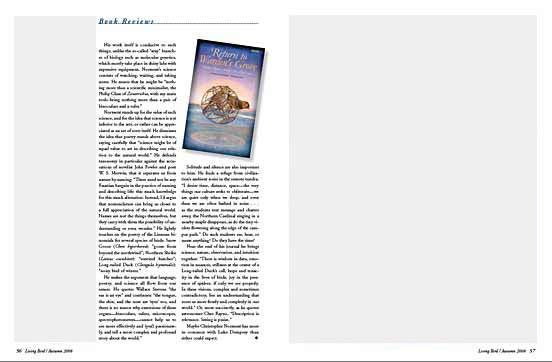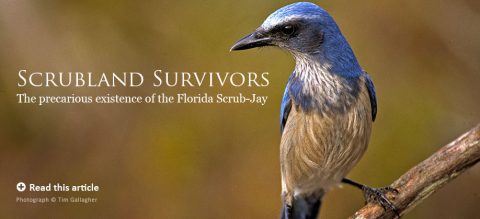Book Review: Return to Warden’s Grove, by Christopher Norment
Reviewed by Stephen J. Bodio October 15, 2008
Christopher Norment’s Return to Warden’s Grove is something very different: a working biologist’s musings on science and art, life and death, silence and solitude, and “right practice,” all seen through the lens of the three years the author spent studying Harris’s Sparrows from a derelict cabin on the Canadian tundra. While trapping, banding, collecting, and enumerating, he was on a quest that might be summarized by this passage: “Why should I have had the hubris to believe that I could enter into a dialog with Harris’s Sparrows, and understand anything about the working of their minds? I desired to travel into the deepest unmapped country, but I had no way of seeing the terrain.”
The physical terrain of his study is daunting: to get there, he flies over more than 300 uninhabited miles of tundra northeast of Yellowknife, itself a remote location. Once there, the two scientists are on their own in a region of hungry grizzlies, watchful wolves, and such numbers of mosquitoes that even reading about them can make you uncomfortable. (Of the bears, he says: “It struck me that I was behaving like a foraging Harris’s Sparrow—for the most part focused on the task before me, but always vigilant and looking up every minute or so to scan for predators. It never was possible for me to forget my status in the world; as the Northern Shrikes were famous to the sparrows, the bears were famous to me.”) But he finds inspiration and even the Buddhist notion of right practice in simplicity, solitude, and silence.
His work itself is conducive to such things; unlike the so-called “sexy” branches of biology such as molecular genetics, which mostly take place in shiny labs with expensive equipment, Norment’s science consists of watching, waiting, and taking notes. He muses that he might be “nothing more than a scientific minimalist, the Philip Glass of Zonotrichia, with my main tools being nothing more than a pair of binoculars and a ruler.”
Norment stands up for the value of such science, and for the idea that science is not inferior to the arts, or rather can be appreciated as an art of sorts itself. He dismisses the idea that poetry stands above science, saying carefully that “science might be of equal value to art in describing our relation to the natural world.” He defends taxonomy in particular against the accusations of novelist John Fowles and poet W. S. Merwin, that it separates us from nature by naming: “There need not be any Faustian bargain in the practice of naming and describing life: this much knowledge for this much alienation. Instead, I’d argue that nomenclature can bring us closer to a full appreciation of the natural world. Names are not the things themselves, but they carry with them the possibility of understanding or even wonder.” He lightly touches on the poetry of the Linnean binomials for several species of birds: Snow Goose (Chen hyperborea): “goose from beyond the northwind”; Northern Shrike (Lanius excubitor): “sentinel butcher”; Long-tailed Duck (Clangula hymenalis): “noisy bird of winter.”
He makes the argument that language, poetry, and science all flow from our senses. He quotes Wallace Stevens “the ear is an eye” and continues: “the tongue, the skin, and the nose are ‘eyes’ too, and there is no reason why extensions of these organs—binoculars, rulers, microscopes, spectrophotometers—cannot help us to see more effectively and (yes!) passionately, and tell a more complex and profound story about the world.”
Solitude and silence are also important to him. He finds a refuge from civilization’s ambient noise in the remote tundra. “I desire time, distance, space—the very things our culture seeks to obliterate—we are quiet only when we sleep, and even then we are often bathed in noise . . . as the students text message and chatter away, the Northern Cardinal singing in a nearby maple disappears, as do the tiny violets flowering along the edge of the campus path.” Do such students see, hear, or name anything? Do they have the time?
Near the end of his journal he brings science, nature, observation, and intuition together: “There is wisdom in data, emotion in nuances, stillness at the center of a Long-tailed Duck’s call, hope and tenacity in the lives of birds, joy in the presence of spiders, if only we see properly. In these visions, complex and sometimes contradictory, lies an understanding that roots us more firmly and complexly in our world.” Or, more succinctly, as he quotes astronomer Chet Rayno, “Description is relevance. Seeing is praise.”
Maybe Christopher Norment has more in common with Luke Dempsey than either could expect.

All About Birds
is a free resource
Available for everyone,
funded by donors like you
American Kestrel by Blair Dudeck / Macaulay Library



